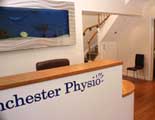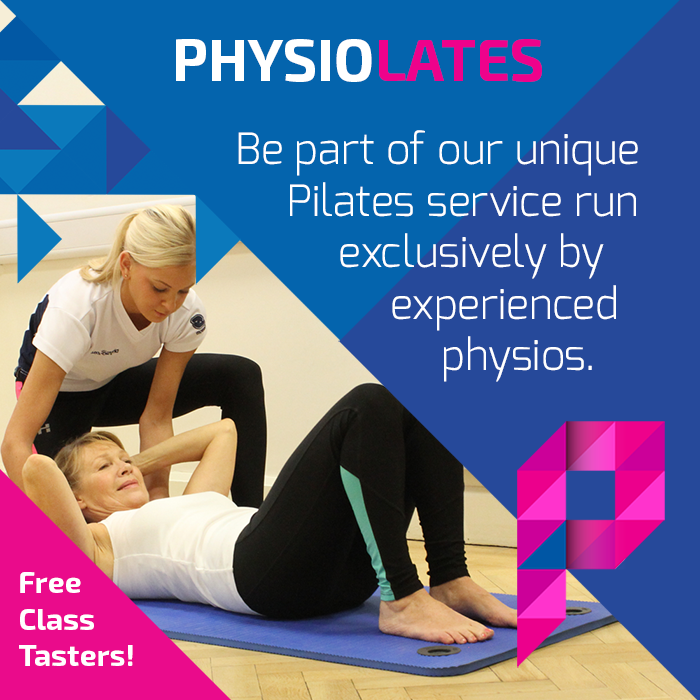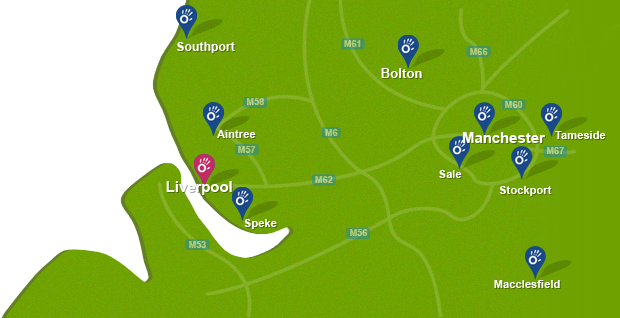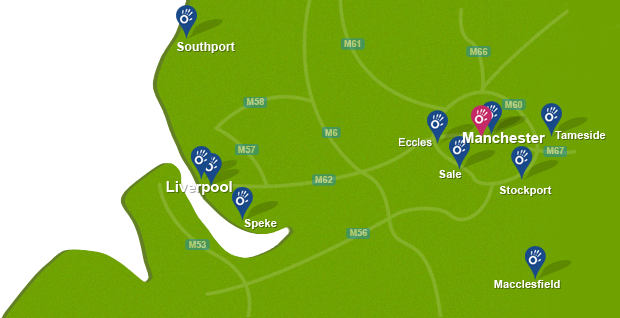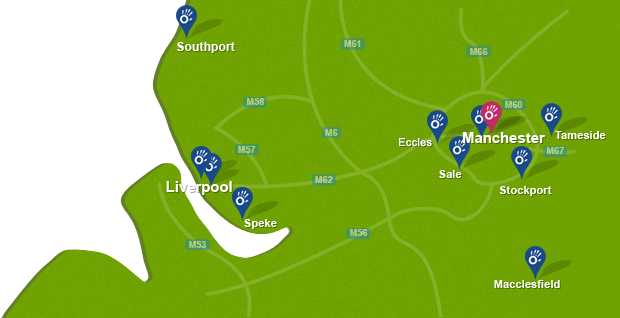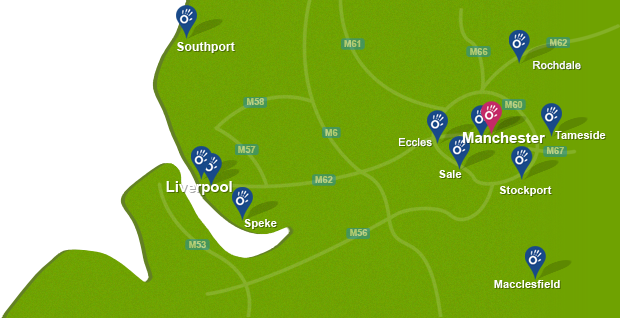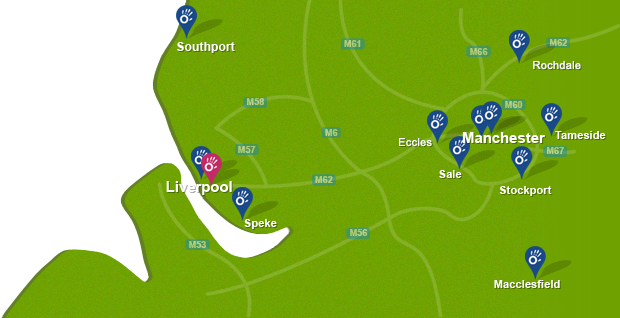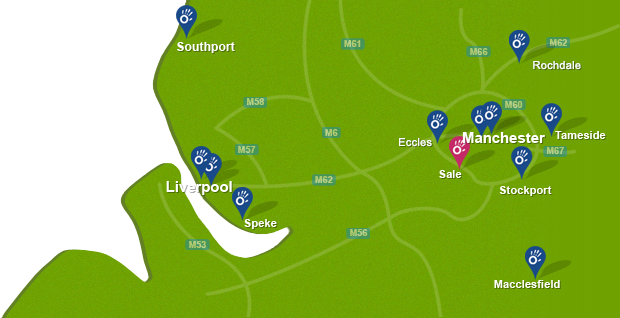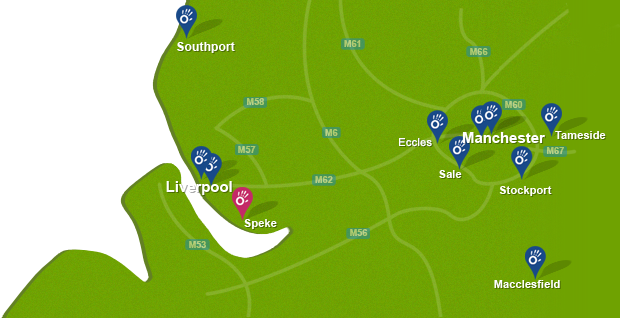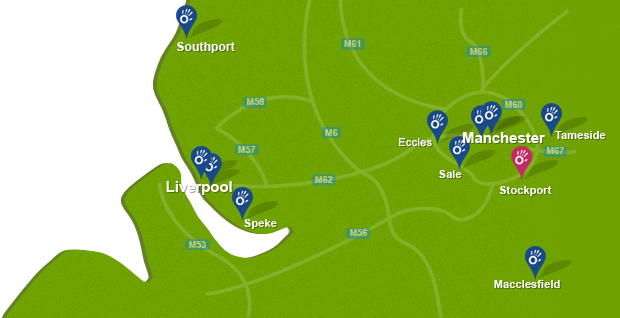A common benefit of massage is the relief of tight muscles. Tight muscles can be caused by overuse, injury and poor posture. Range of movement is restricted when muscles are tight and an increase in pain can occur. Various techniques are used within many different styles of massage to help relieve tight muscles. Our massage therapists at Physio.co.uk relieve tight muscles through massage to help increase range of movement, decrease pain and increase relaxation.
What are the most appropriate types of massage to relieve tight muscles?
There are many different types of massage that can be used to relieve tight muscles. The most common types of massage used to decrease tight muscles include:
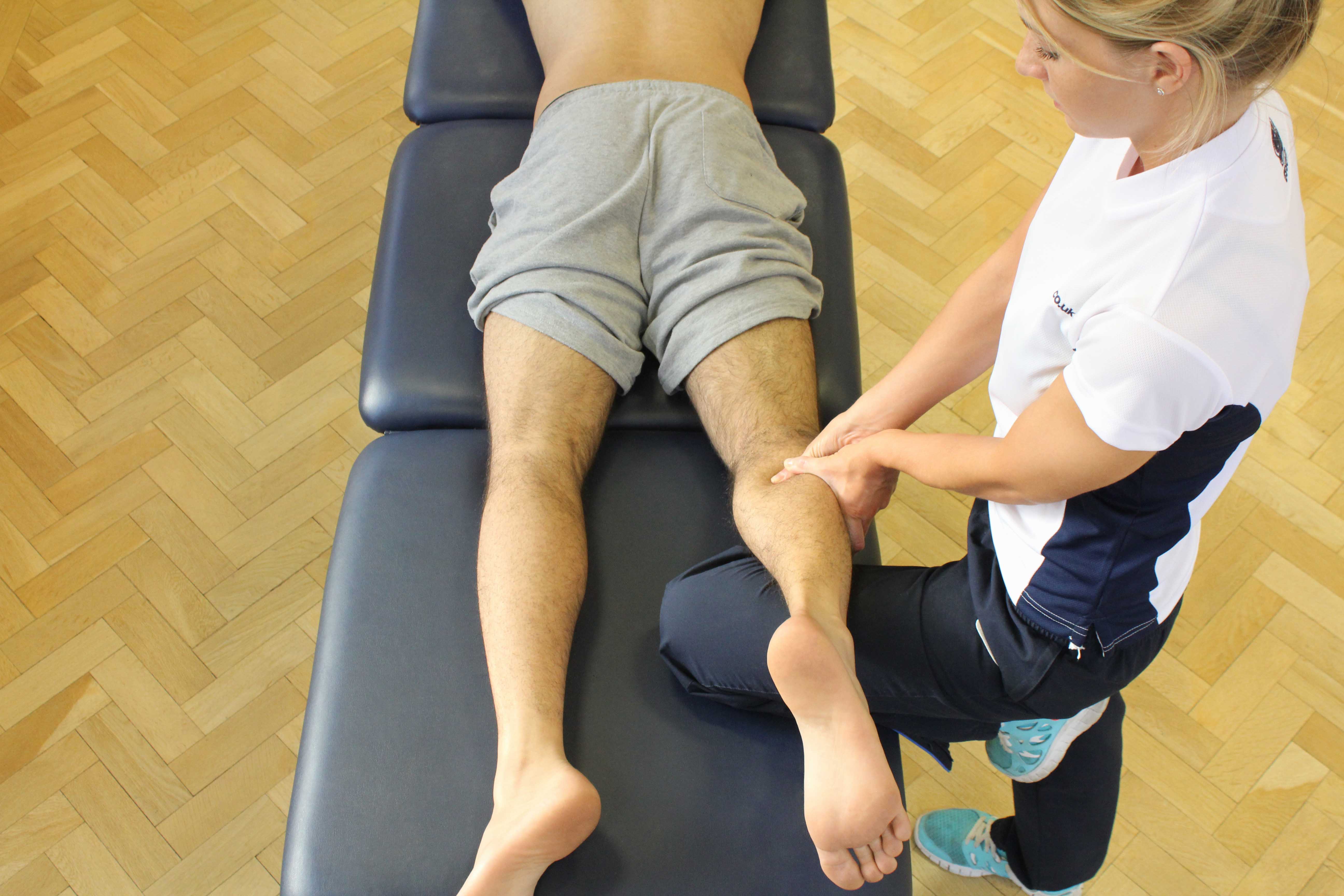 Above: Trigger point massage of gastrocnemius to release knotted muscle and tightness
Above: Trigger point massage of gastrocnemius to release knotted muscle and tightnessThe most common types of massage used to relieve tight muscles include deep tissue massage, sports massage and remedial massage.
Deep tissue massage can be used to relieve tight muscles. A deep tissue massage is aimed at treating deeper layers of muscle and fascia. It involves using a firm, deep pressure combined with various different techniques. A deep tissue massage allows muscles to move more freely as inelasticity of muscular tissues is reduced. Inelastic muscular tissues caused restriction and increases muscle tightness. A reduction in muscular inelasticity occurs as blood flow increases, rising muscle temperature. Allowing muscles to move more freely by reducing inelasticity of the tissues helps to relieve muscle tightness.
Tight muscles can be relieved through sports massage. A sports massage is an intense massage focused on areas containing soft tissues. A sports massage involves using a range of techniques to help get deeper within muscles to increase their temperature. Increasing the temperature of muscles through sports massage increases tissue elasticity. An increase in tissue elasticity helps to reduce restriction and increases a muscle's flexibility and range of movement. An increase in flexibility and range of movement relieves muscle tightness.
Remedial massage can relieve tight muscles. Remedial massage can be used to help treat both superficial and deep muscles. The manipulation of muscles occurs throughout remedial massage as well as a therapeutic effect. Remedial massage helps to stretch and loosen muscles by encouraging an improvement in blood flow. An improvement in blood flow rises muscle temperature, allowing the stretching and loosening of muscles to occur. A decrease in restriction follows when muscles have been loosened, relieving muscle tightness.
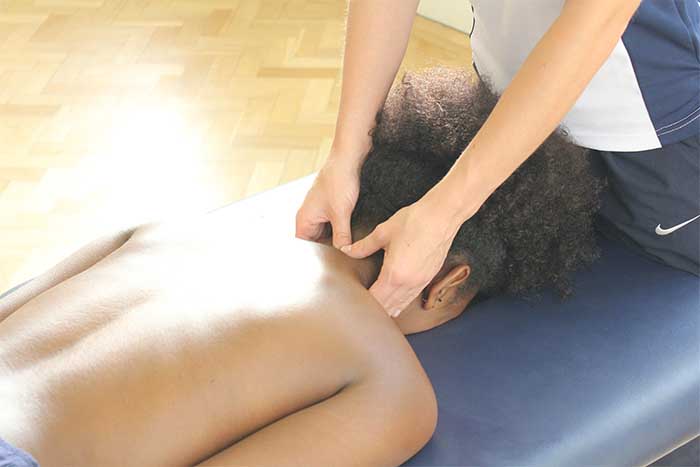
What techniques are used to relieve tight muscles?
A variety of techniques are used to relieve tight muscles. The most common techniques used to relieve tight muscles include:
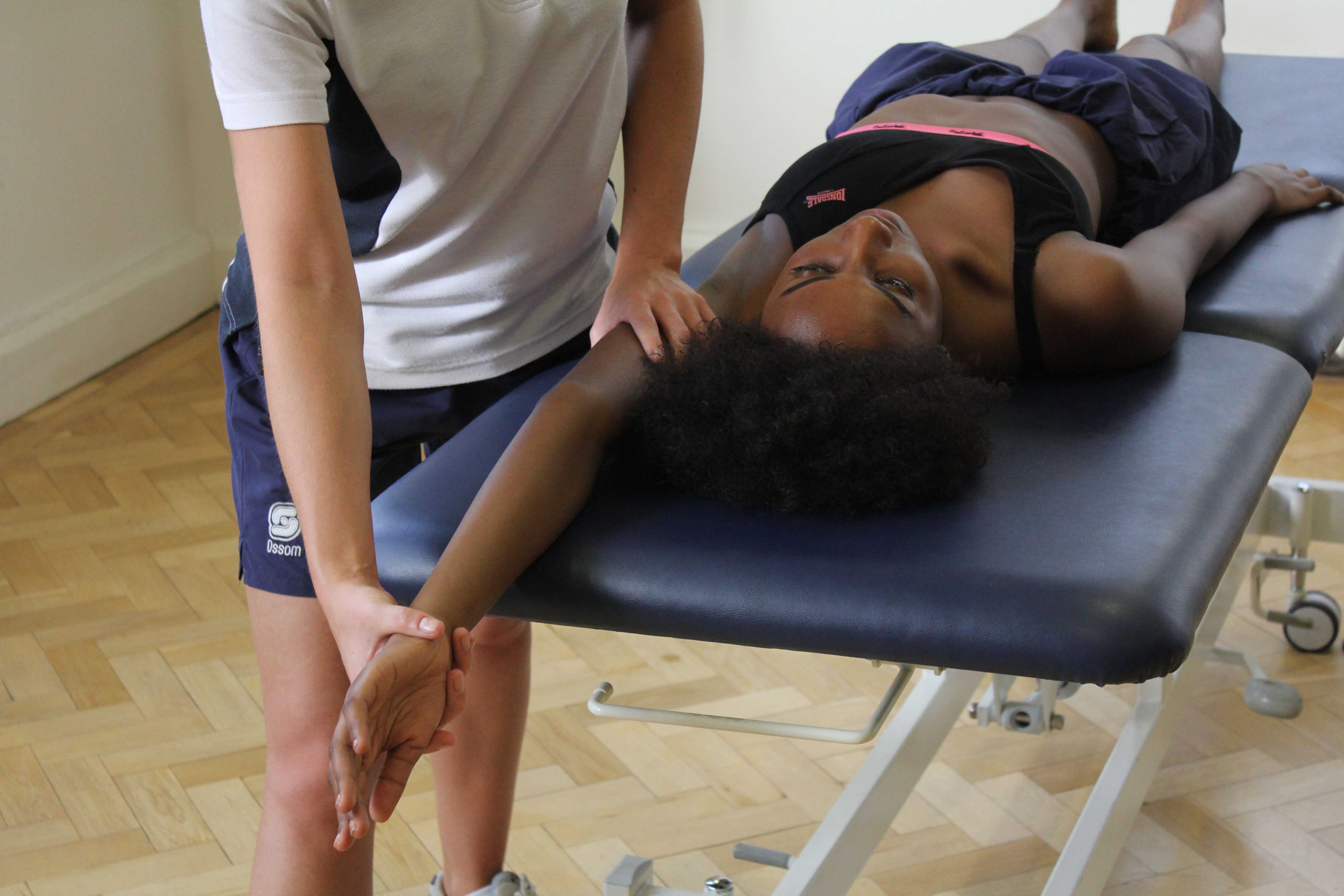 Above: Massage and stretch of glenohumeral joint to ease tight muscles
Above: Massage and stretch of glenohumeral joint to ease tight musclesDeep strokes, kneading and skin rolling are the most common techniques used to relieve tight muscles.
Deep strokes can be used to relieve tight muscles. Deep strokes involve applying a firm pressure to the treatment area using flattened hands and fingers. The firm pressure used enables to hands to get deeper into muscles. Deep strokes help to stretch muscles, improving muscle elasticity and flexibility. An improvement in muscular elasticity and flexibility allows muscles to move freely with no restriction. Restriction in movement can increase muscle tightness resulting in pain. Reducing restriction by improving muscular elasticity and flexibility relieves muscle tightness and pain.
Kneading is often used to relieve tight muscles. Kneading is where areas containing soft tissues are pulled and squeezed. The pulling and squeezing actions used within kneading, encourage an increase in blood flow to the treatment area. An increase in blood flow causes muscle temperature to rise. A rise in muscle temperature allows the muscle to loosen and relax as tension is reduced. A decrease in tension within muscles helps to reduce muscular knots that cause muscles to tighten and become painful. Loosened, relaxed and tension free muscles all contribute towards relieving muscle tightness.
Tight muscles can be relieved using skin rolling. Skin rolling involves picking up and rolling skin between the fingers and thumbs. Friction is created when the skin is rolled between fingers, encouraging and improvement in blood flow. An improvement in blood flow helps to increase the temperature of muscles and fascia. Fascia is a thin layer of connective tissues located beneath the skin's surface that often becomes restrictive. Increasing the temperature of muscles and fascia through skin rolling helps to separate both layers of muscular tissues and connective tissues. Fascia and muscles are separated as skin rolling helps to stretch and loosen tissues. Separating the fascia tissues from the muscle tissues helps to decrease restriction and relieve muscle tightness.
When can a massage help to relieve tight muscles?
A massage can help to relieve tight muscles in many situations. The most common situations massage is used to relieve tight muscles include:
Massage can be used to relieve tight muscles to help acute pain, pre event and relaxation.
Acute pain can be reduced when tight muscles are relieved. Muscle tightness can cause a buildup of tension within muscles. A buildup of tension can create muscular knots that increase pain and restriction, further increasing muscle tightness. When tightness is relieved, muscles are able to relax, reducing tension. A decrease in tension helps to reduce muscular knots and the restriction that they have caused. A reduction in muscular knots and restriction helps to increase range of movement and decrease pain.
The relief of tight muscles can help pre event. When muscles are tight, range of movement is restricted and chances of injury are higher. If a person, during the event, uses short bursts of movement or tries to stretch a muscle further than it allows, injuries such as muscle pulls, strains and tears are likely to occur. Relieving tight muscles helps to prepare a person for event by increasing range of movement and decreasing restriction. Muscle flexibility and elasticity is also increased when muscle tightness is relieved, further increasing range of movement. An increase in the range of movement and flexibility of muscles helps to reduce chances of injury during the event. Short bursts of movement are less likely to cause damage and the amount a muscle is able to stretch is increased.
Relaxation can be increased when tight muscles are relieved. Tight muscles can increase stress and tension within muscles as movement is restricted. Restriction in movement can often increase pain. Pain caused by restriction in movement can cause an increase in stress mentally as normal daily activities become harder to do. A person becomes physically unable to relax due to restriction in movement and mentally unable to relax due to stress. When muscle tightness is relieved a person is physically able to relax as restriction is reduced and movement is increased. An increase in movement reduces pain and mentally allows a person to relax.
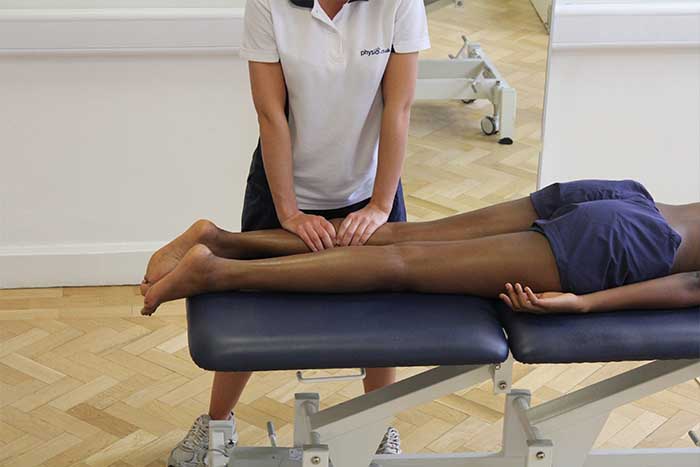
What are the physiological effects of massage to relieve tight muscles?
There are a range of physiological effects of massage to relieve tight muscles. The most common physiological effects include:
The physiological effects of massage to relieve tight muscles include increased vasodilation, increased temperature and increased tissue elasticity.
A physiological effect of massage to relieve tight muscles is increased vasodilation. Vasodilation is where blood vessels widen and come closer to the surface of the skin. Vasodilation increases blood circulation as the amount of blood able to travel through the blood vessels increases as they dilate. An increase in blood circulation encourages an increase in muscle temperature as well as supplying muscles with an increase in healthy oxygen and nutrients. An increase in muscle temperature improves tissue elasticity allowing muscles to move with no restriction. Reducing restriction by increasing tissue elasticity relieves tight muscles.
Increased temperature is a physiological effect of massage to relieve tight muscles. During a massage, friction is created between the skin and hands. Friction created increases blood flow to and around the treatment area. An increase in blood flow, rises muscle temperature. A rise in muscle temperature relieves tight muscles as flexibility and range of movement are both improved.
Increased tissue elasticity is a common physiological effect of massage to relieve tight muscles. Throughout a massage, a variety of techniques are used to increase muscle temperature. An increase in muscle temperature increases the elasticity of tissues, enabling them to relax and loosen. Relaxed and loosened tissues relieves tight muscles as tension is reduced and restriction is decreased.
Summary
The relief of tight muscles is where tightness caused by poor posture or overuse is reduced by decreasing restriction and removing muscular knots. There are many different types of massage that can be used to relieve tight muscles including deep tissue massage, sports massage and remedial massage. Various techniques including deep strokes, kneading and skin rolling are all used within the different types of massage to relieve tight muscles. Relieving tight muscles through massage can help reduce pain, prepare a person for an event and increase relaxation. There are many physiological effects that occur to help relieve tight muscles including increased vasodilation, increased temperature and increase tissue elasticity. Our massage therapists at Physio.co.uk relieve tight muscles through massage to help decrease restriction, reduce muscular knots and increase range of movement.
How can I arrange a massage to relieve tight muscles?
The easiest way to arrange a massage to relieve tight muscles at Physio.co.uk is to email us at office@physio.co.uk or call us on 0800 033 7800.
You can also book an appointment online and save £10
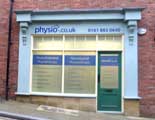
 0330 088 7800
0330 088 7800